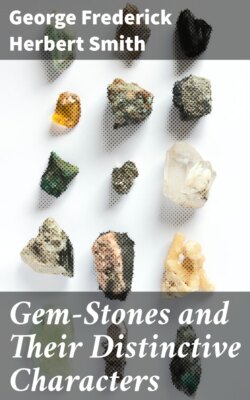Читать книгу Gem-Stones and Their Distinctive Characters - George Frederick Herbert Smith - Страница 11
На сайте Литреса книга снята с продажи.
CHAPTER V
ОглавлениеTable of Contents
LUSTRE AND SHEEN
IT has been already stated that whenever light in one medium falls upon the surface separating it from another medium some of the light is reflected within the first, while the remainder passes out into the second medium, except when the first is of lower refractivity than the second and light falls at an angle greater than that of total-reflection. Similarly, when light impinges upon a cut stone some of it is reflected and the remainder passes into the stone. What is the relative amount of reflected light depends upon the nature of the stone—its refractivity and hardness—and determines its lustre; the greater the amount the more lustrous will the stone appear. There are different kinds of lustre, and the intensity of each depends on the polish of the surface. From a dull, i.e. an uneven, surface the reflected light is scattered, and there are no brilliant reflections. All gem-stones take a good polish, and have therefore, so long as the surface retains its polish, considerable brilliancy; turquoise, on account of its softness, is always comparatively dull.
The different kinds of lustre are—
1 Adamantine, characteristic of diamond.
2 Vitreous, as seen on the surface of fractured glass.
3 Resinous, as shown by resins.
Zircon and demantoid, the green garnet called by jewellers “olivine,” alone among gem-stones have a lustre approaching that of diamond. The remainder all have a vitreous lustre, though varying in degree, the harder and the more refractive species being on the whole the more lustrous.
Some stones—for instance, a cinnamon garnet—appear to have a certain greasiness in the lustre, which is caused by stray reflections from inclusions or other breaks in the homogeneity of the interior. A pearly lustre, which arises from cleavage cracks and is typically displayed by the cleavage face of topaz, would be seen in a cut stone only when flawed.
Certain corundums when viewed in the direction of the crystallographical axis display six narrow lines of light radiating at angles of 60° from a centre in a manner suggestive of the conventional representations of stars. Such stones are consequently known as asterias, or more usually star-stones—star-rubies or star-sapphires, as the case may be, and the phenomenon is called asterism. These stones have not a homogeneous structure, but contain tube-like cavities regularly arranged at angles of 60° in planes at right angles to the crystallographical axis. The effect is best produced when the stones are cut en cabochon perpendicular to that axis.
Chatoyancy is a somewhat similar phenomenon, but in this case the fibres or cavities are parallel to a single direction, and a single broadish band is displayed at right angles to it. Cat’s-eyes, as these stones are termed, are cut en cabochon parallel to the fibres. The true cat’s-eye (Plate XXIX, Fig. 1) is a variety of chrysoberyl, but the term is also often applied to quartz showing a similar appearance. The latter is really a fibrous mineral, such as asbestos, which has become converted into silica. The beautiful tiger’s-eye from South Africa is a silicified crocidolite, the original blue colour of which has been altered by oxidation to golden brown. Recently tourmalines have been discovered which are sufficiently fibrous in structure to display an effective chatoyancy.
The milky sheen of moonstone (Plate XXIX, Fig. 4) owes its effect to reflections from twin lamellæ. The wonderful iridescence which is the glory of opal, and is therefore termed opalescence, arises from a structure which is peculiar to that species. Opal is a solidified jelly; on cooling it has become riddled with extremely thin cracks, which were subsequently filled with similar material of slightly different refractivity, and thus it consists of a series of films. At the surface of each film interference of light takes place just as at the surface of a soap-bubble, and the more evenly the films are spaced apart the more uniform is the colour displayed, the actual tint depending upon the thickness of the films traversed by the light giving rise to the phenomenon.
